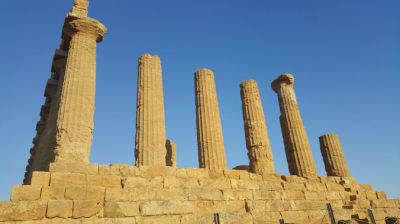When I was young, if I said I was Italian, my mother would correct me, “You are only half Italian. The other half is Sicilian.” At the time, I thought she was just being difficult. I learned later that many Sicilians, at least of her generation, felt the same way. They were Sicilians, not Italians. Being Italian was more an accident of history, the result of just another invader taking the island. They saw the Italians as no different than the Saracens, Normans, or Spanish.
While some may be offended at the suggestion that Sicilians are something other than red, white, and green Italians, one cannot argue that they are indeed unique. Consider some key characteristics that define a culture: language, cuisine, and values. True, the regional cultures of Italy vary. But these differences are more the differences between siblings, while the culture of Sicily is more of a cousin, maybe even a second or third cousin. This begs the question of why Sicily is so unique.
Looking back on Italian history, we see that most of the peninsula was relatively free of foreign dominance. Venice, for example, protected by the shoals of its lagoon, wasn’t invaded until the 1800s when Napoleon set his sights on the island city. While there were foreign incursions, no Italian region suffered occupation as frequently or severely as Sicily. The island is in the virtual center of the Mediterranean, making it the way station of every invader entering Europe, from the 8th century BCE Greeks to the 20th century’s Allied Forces. Many were doing more than simply passing through. The indigenous peoples of Sicily, the Elymians, Sicani, and Sicels, were assimilated into the third-millennium BC Greek colonies. Afterward, the Phoenicians, Carthaginians, Muslims, Normans, and Spanish, to name a few, all ruled Sicily for extended periods, each making their mark on the island’s culture.
An excellent example of how these interactions affected Sicily is its language. The regional versions of the Italian language evolved from the Latin Vulgate, an informal Latin spoken by ordinary people. Separated by geography, each region’s vernacular evolved with little outside influence. However, Sicilian, shaped by the influences of other cultures, evolved into a unique language. Not only did Sicilians integrate the vocabularies of other languages, such as Greek, Hebrew, and Arabic, into their speech, but they have their own grammar and pronunciation.
Another difference between Sicily and the rest of Italy is its food. Sicilian cuisine emphasizes seafood, citrus fruits, and aromatic spices, blending these ingredients into something distinctly Sicilian. They also seem to put a greater emphasis on seafood. After my last visit to the island, I was so sick of sardines and calamari that I ate nothing but red meat for weeks afterward. When it comes to food, though, Sicily has contributed dishes that are icons of the Italian menu. The most famous of these are arancini and cannoli.
Where Sicily truly stands out from the rest of Italy, however, is in its street food. Here, it seems to have more in common with Spain than the rest of Italy. Walking down the Via Vittorio Emanuele in Palermo was more reminiscent of Mercado de San Miguel in Madrid or La Ramba in Barcelona than anything in Rome or Milan. It was on the Via Vittorio, after sampling the wares of at least half a dozen different eateries, that I first experienced “brioche con gelato.”
Sicily is unique even when it comes to desserts. In ancient Persia, the nobility would blend fruit, vermicelli, and rose water with ice. Centuries later, the Arabs mixed in fruit syrups, creating the first sorbets. Sicilians improved on what the Arabs brought to the island, creating granita, an icy blend of fruit juices with a slushy consistency. Travel tip: When in Sicily, never refer to granita as a Slushie.
Sicily is a unique and wonderful place. It has brought together the best of many cultures to create something magnificently distinct. I am quite proud of my cultural inheritance. And, after all these years, I can proudly say, “I am only half Italian. The other half is Sicilian through my mother.”
https://www.lagazzettaitaliana.com/history-culture/10638-italian-or-sicilian#sigProIdf6e5b54d4c
All photos courtesy of William Giovinazzo




